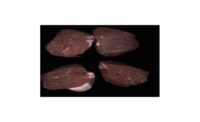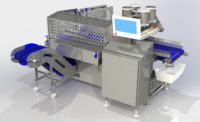Foreign material detection and product inspection

Foreign material detection is very important in food safety—if a piece of metal or something similar is missed during inspection, for example, it could make its way into consumers’ homes, thus leading to a recall.
Current trends
“Food recalls due to foreign object contamination are on the rise in the U.S.,” says Bob Ries, lead product manager, metal detection and X-ray inspection, Thermo Fisher Scientific, Waltham, MA.
Savvy food processes are seeking proactive solutions to help avoid them in the first place, he says.
“Since many food processors only replace detection technologies every 10 years, when they’re making an investment in new equipment, the bar is raised on performance expectations; they want the best form of brand insurance available as part of their overall food safety plan to meet the needs of today and tomorrow. There’s keen interest in solutions that can find more types and smaller foreign objects versus a minimum-capability parity product.”
Several other drivers are behind this trend, he notes.
“A recall is an acute and expensive event from which a brand may not fully recover. There is the immediate concern of consumer safety, but also a potential loss of loyal customers. It’s also so easy today for a consumer to amplify concerns via social media, which can rapidly turn a minor incident into a major news story,” Ries explains.
With continued pressures to operate more profitably, and with a less-skilled workforce, food processors are looking for technologies that are easier to operate and maintain yet provide real-time and historical data to help optimize their process, he states.
“Finally, whether for new plant design or reconfiguration within an established footprint, space can be at a premium. To help maximize available square footage, technologies such as combination metal detector/checkweigher systems for metal foreign object detection and inline weighing, a metal detector integrated onto the checkweigher frame saves space and money, while providing seamless operation through integrated software for set-up and data review.”
Robert Rogers, senior advisor for food safety and regulation, Mettler Toledo Product Inspection, Lutz, FL, says that food manufacturers are challenged with maintaining efficient, safe, sustainable and economic food processing and packaging systems.
“Product inspection systems need to do more than simply inspect the product. A stable and robust Product Inspection Program that is properly validated and maintained can not only ensure product safety and quality, but can also assist in meeting the company’s business challenges,” he recommends.
As an example, one of the many benefits of the Mettler Toledo Profile Advantage metal detector, its newest metal detection system, is a major reduction in false rejects in challenging applications, Rogers says.
“The Profile Advantage incorporates multiple simultaneous frequencies which reduces the incidence of false rejects due to moisture or other conductive elements in products that can mimic metal contamination. A reduction in those false rejects equates to more efficient production and a reduction of waste, directly affecting the company’s profitability.”
Rogers says they are also seeing many organizations utilizing Product Inspection solutions throughout their production processes, rather than only at the end of the production line.
“Identifying and removing non-conforming or contaminated products as early in the process as possible in the production cycle, before further value has been added, directly impacts efficiencies and waste. In addition, ProdX, Mettler Toledo’s software data collection solution, enables companies to connect to all Mettler Toledo inspection solutions within its processes, even across multiple facilities, allowing data such as reject information, setting adjustments and condition monitoring to be quickly reviewed in order to highlight areas that need attention and also to provide an audit trail of activity that can be valuable in the event of an FDA inspection.”
Juan Sarable, general manager, Silgan Equipment Company, says that Vision Inspection on Full Sleeve Labels for customers is trending upward.
“We are now able to conduct inspections of full sleeve labels with our existing 51R84/85 vision systems, identifying Missing Labels, Label Tears, High/Low Labels and Label Integrity,” he says.
Erik Brainard, president and CEO, Anritsu Infivis Inc., Elk Grove Village, IL, says that with the 2019 FSIS 9CFR418.2 directive/guideline which followed FSMA (Food Safety Modernization Act) a few years back, the ability to prevent recalls continues to be front of mind for CPGs.
“The days of reacting to problems are gone. There is a new emphasis to understand the detection technology and how to manage it when there is an FM issue. A device with low to zero false rejects is imperative for plant personnel to trust there is a real issue and to vigorously investigate the issue in real time,” he notes.
Systems can alarm the factory and QA teams when frequent rejects are evident so there can be a real time analysis of an issue prior to release to the consumer, Brainard explains.
“Using the technology correctly—e.g., positioning equipment properly on the line—is critical to maximizing detection performance and preventing consumer complaints and recalls. High Definition and DualX X-ray technology, as designed and supplied by Anritsu, provides the ability to detect more foreign materials in bulk or packaged products with virtually zero false rejects.”
Brainard says that the reject device plays a significant role.
“When an issue is detected, removing the product from production is paramount to any HACCP strategy. We have developed reject systems with fail-safe monitoring that assures any adulterated product is physically removed and secured for QA analysis.”
Data is critical to the success of any inspection solution, too, he says.
“The Anritsu systems connect to many protocols seen at CPGs. We offer our own data collection and analysis system (QuiCCA) to monitor and report on all connected Anritsu technology at a facility. Monitoring in real time and seeing archives of rejected x-ray images adds value for QA and helps identify equipment issues that may be creating foreign material concerns.”
It is critical to find the smallest concerns on a production line without false rejects, Brainard remarks.
“When technology provides maximum capabilities, the overall operational equipment effectiveness (OEE) and total cost of ownership (TCO) improve. That is our goal at Anritsu.”
(sub) New and updated machinery
Brainard says that Anritsu’s most recent product launch is its second generation XR75 DualX system for poultry and meat trim products.
“We use our second-generation of HD Dual Energy technology to find the smallest bones and other low-density contaminants with virtually zero false rejects, all within an IP69k, sanitary design cabinet and conveyor. Second Generation XR75 DualX in a standard conveyor format is also available to find high and low density contaminants in packaged products,” he says.
Sarable says that the conversion of the Silgan Equipment 51R56G Cap Inspection Vision System to Windows 10 software allows for faster processing speeds and better software integration.
The latest inspection technology from Thermo Fisher is a metal detection technique called multiscan, says Ries.
“This technology allows our Thermo Scientific Sentinel Multiscan Metal Detectors to detect contaminants that are 35-50 percent smaller in volume than previous technologies. The Sentinel 5000 conveyor model was the first multiscan metal detection platform capable of overcoming the limitations of fixed single or dual frequency metal detectors by scanning a combination of up to five user-selectable frequencies to find all random sizes, shapes and types of metal foreign objects.”
Thermo Fisher also recently launched the Sentinel 3000, a compact model for metal detection-checkweighing combination systems.
“The Sentinel 3000 can be mounted onto the weighing frame of the Thermo Scientific VersaWeigh and Versa GP checkweighers, reducing the total footprint while enabling important functions like program changes, alarms and rejection statistics. We’ve also added a new software functionality available as a standard feature in the Thermo Scientific Sentinel multiscan metal detectors called Auto Learn. Auto Learn makes the set-up process easier and quicker by allowing users to conduct an initial set-up stage that can capture data on products contaminated with metal foreign objects. This enables fast and easy system calibration that can be optimized for specific applications,” Ries explains.
Related: Slideshow: Foreign material detection and product inspection
Looking for a reprint of this article?
From high-res PDFs to custom plaques, order your copy today!






